Analysis: 'Age-heaping' may explain the huge over-representation of people with ages ending in zero or five in past Irish censuses
By Eoin McLaughlin, Heriot-Watt University; Chris Colvin, Queen's University Belfast and Stuart Henderson, Ulster University
When we look at Irish censuses from the past, there is an unusual overrepresentation of people with ages ending in zero or five. This phenomenon is known as "age-heaping" or "digit preference", or even "age preference". You only have to glance at an Irish population pyramid from 1841 and 1871 to see the apparent anomalies – the picture is less of pyramid and more like a navy vessel.
Looking closer, the concentration of ages is especially marked at 30, 40, 50, and 60. A similar pattern is seen in the 1871 census. Something unusual is going on unless Irish people were only conceived and born every five years.
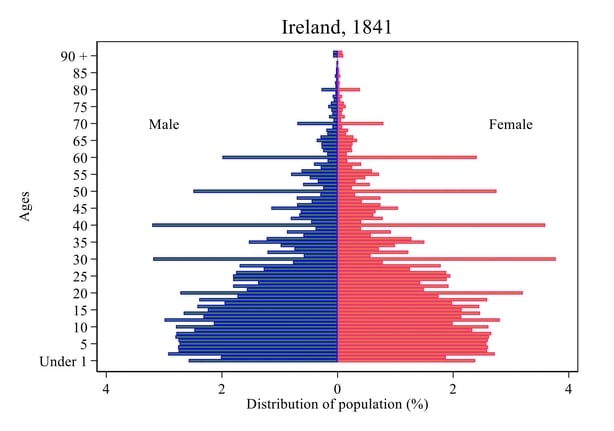
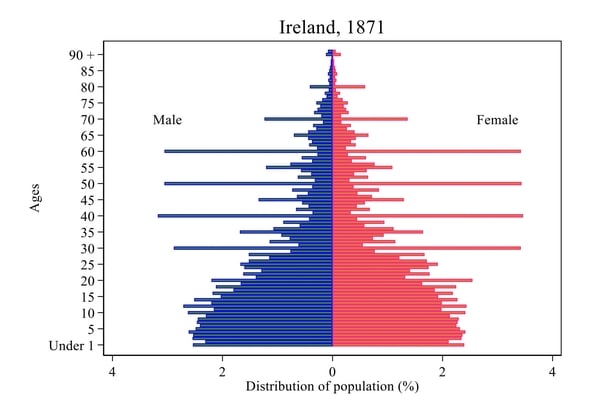
This phenomenon is not a uniquely Irish problem and demographers have been aware of the issue since the early 20th century. A way to measure it was devised by George Chandler Whipple (1866-1924), a professor of sanitary engineering at Harvard and a co-founder of the Harvard School of Public Health. The Whipple Index is described in his Vital Statistics textbook as a "method of adjusting data troubled with these concentrations on the round numbers".
Whipple compares the ratio of ages ending in 0 or 5 to all ages, restricting the calculation to people aged 23-62. If there is no heaping, then the index will be 100, and if all people heap then it will be 500 (i.e. 5 times more people with ages ending with 5 or 0 than we would expect).
Heaping in important historical source material has led to some challenges and opportunities for researchers. Before the civil registration of births, deaths and marriages commenced in 1864, age heaping blighted studies that needed accurate age statements. For example, studies of the age of marriage in pre-Famine Ireland are tentative because it is difficult to know with certainty what age people were based on in the 1841 census.
People with poor arithmetical capability would be more inclined to report a rounded age
Some scholars have used the age heaping to gauge something about the level of numeracy. In a now iconic paper, Cormac Ó Gráda and Joel Mokyr used age statements from passenger lists arriving in the United States to compare Irish emigrants with the population that remained in Ireland. The argument being that 'people with poor arithmetical capability would be more inclined to report a rounded age than educated persons. It is also possible that more sophisticated people are more acutely aware of the notion of time, including their own age.’ They found that emigrants were more likely to report inaccurate age statements compared with the census population.
This innovative study spurred interest in age heaping as a measure of basic numeracy. Economic historians have used age heaping data to make inferences about the education and educational attainment of populations. The Whipple Index was repurposed and converted into a new index called the ABCC index named after the authors of the study (Brian A’Hearn, Jörg Baten, Dorothee Crayon) and Greg Clark. The new index, while still based on the idea of Whipple, was out of 100 with a lower score indicating higher heaping.
Age heaping puzzle
Here's the ABCC index for Ireland in 1841 and 1871. Surprisingly, Ireland’s ABCC score decreased after the famine and heaping became more pronounced. This is confusing because age heaping tends to be associated with lower levels of education and poorer communities. But Ireland had a big increase in schooling and associated literacy after the Famine and the Irish economy was growing, so why did Irish age heaping increase?
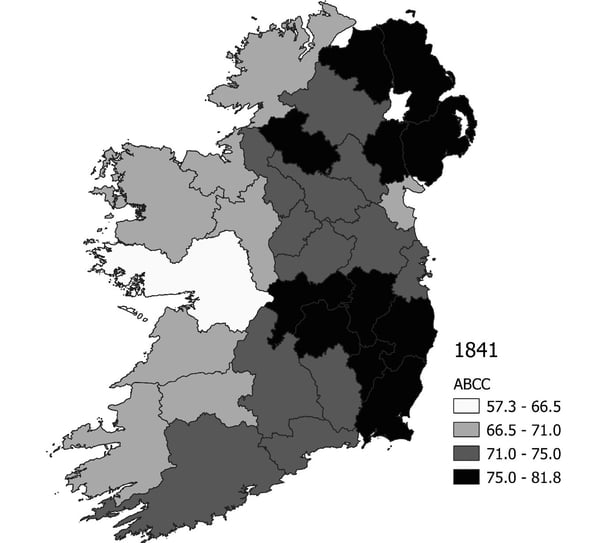
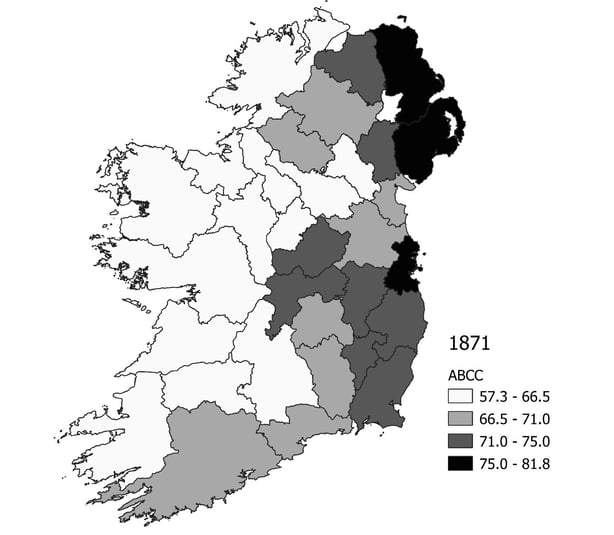
We addressed this puzzle in our recent work and found a simple solution to the puzzle: the Irish heaped more because Ireland had 'prematurely aged' after the Famine. Because of emigration flows, the youngest cohorts were the most likely to emigrate and the population that stayed in Ireland was older as a result. And since heaping is more pronounced with age, Ireland heaped more after the Famine because it was older.
If we want to compare across censuses, we need a way to standardise for differences in population age structure. That’s why we created a new age-standardised Whipple Index.
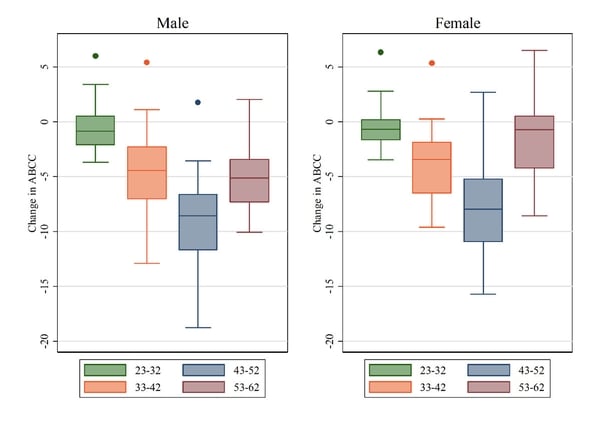
Our methodology explained most of the change in heaping reported in the censuses but the Famine may still had an impact beyond the demographic changes. The Famine experience may also have been a factor why people made less accurate age statements after the traumatic event - especially as it was the older cohorts that had lived through the Famine.
Other factors that may explain the change could be cultural. For example, one of the things that matters is who is actually filling out the census forms. In earlier work, we argued that men were more likely to make census returns in Ireland as the head of the house and that the reported age statements for women reflected the man's digit preferences. Perhaps the increase in age heaping is a reflection of an increasingly patriarchal society.
Does age heaping occur today?
Since 1994, the US Census Bureau has developed specialist software that calculates the Whipple Index, alongside alternative metrics devised by Bachi and Meyers. From 2008, the Bureau applied these metrics to state census returns to ensure consist state and national level demographic indices.
Today, there is no age heaping in official census returns in developed countries because any heaping or age preference that remains has been filtered out. Correcting for heaped ages is not a new development; census enumerators have attempted to correct age distributions at least since the 1840s. However, age heaping is still present in other parts of the world, for example age heaping in the Nigerian census and other survey records is still quite pronounced.
Many people exaggerated their age to qualify for the pension
When and why did the Irish stop age heaping?
Infamously, there was an increase in age heaping after the introduction of the introduction of the old age pension for those aged 70 and above in 1908. Civil registration of births had only commenced in 1864 and, with little proof of age, many people exaggerated their age to qualify for the pension. The test to see if people qualified for the pension was simply if they remembered the 'night of the big wind' in 1839 and reference letters from the local parish priest were used as evidence. People exaggerated their ages on the census forms in 1911 in case this would be used as evidence against them.
The pension heaping also meant that scholars may have seen trends that were statistical illusions. Famously, Raymond Crotty argued that Irish farmers were getting older as a result of land reform policies introduced and, assuming younger farmers were ‘more progressive, energetic, and efficient’, this led to inefficient farming practices. However, as Joe Lee showed in a review of Crotty’s book, the evidence for aging came from the increase in the over 65 population between 1901 and 1911 without reference to the increased heaping after 1908, so comparison of ages across censuses becomes one fraught with challenges.
Aside from the 1908 pension heaping episode, heaping was all but gone by the by the 1950s. But when and why this happened is something for scholars to explore in future research. Maybe this is when Ireland truly modernised or maybe people had birth certificates and passports to hand when answering thorny census questions about their age?
Follow RTÉ Brainstorm on WhatsApp and Instagram for more stories and updates
Prof Eoin McLaughlin is Professor of Economics and Head of Research in the Department of Accountancy, Economics, and Finance in the Edinburgh Business School at Heriot-Watt University. He is a former SFI/Irish Research Council awardee. Dr Chris Colvin is a Reader in the Centre for Economic History at Queen's Business School at Queen's University Belfast. Dr Stuart Henderson is a Senior Lecturer in Financial Services in the Department of Acc, Finance & Economics at Ulster University Business School.
The views expressed here are those of the author and do not represent or reflect the views of RTÉ

